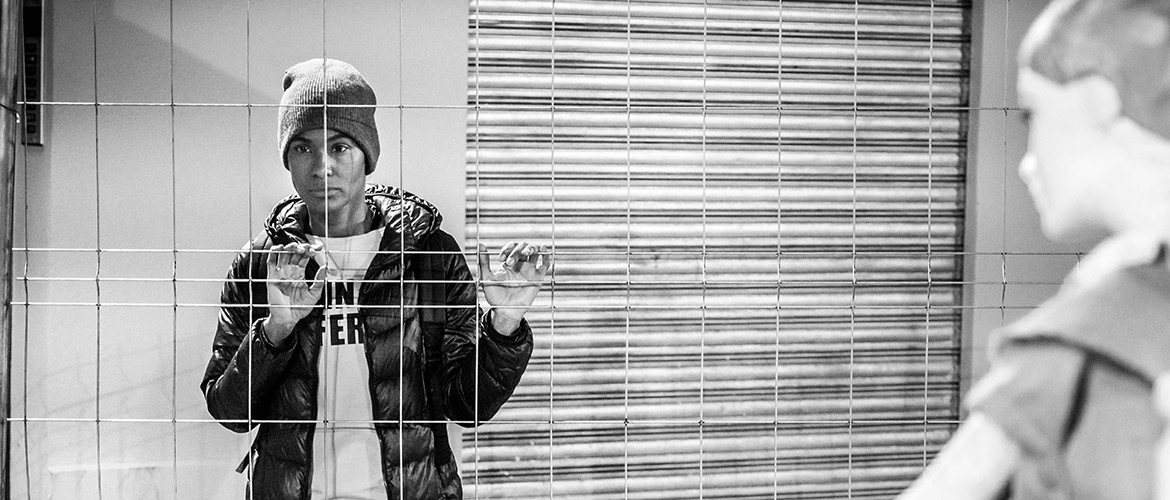Activity Overview
At the level of design, the collaborative film DYSTOPIA explores the representation of PERCEPTIONS themes through an engagement with Film, using visual and non-verbal communication. The Film is directly informed by different materials collected during the project. It focuses on the production and consumption of meanings related to migrants and Europe, which are the central topics of the PERCEPTIONS project. At the level of production and distribution, the Film reflects the cross-border cycle of film-making and different mechanisms of visual communication to reach broader audiences and maximise impact.
D5.9 Imagining PERCEPTIONS findings through an engagement with Film: DYSTOPIA
Description of Activity
Stage 1. Exploring the production and consumption of perceptions and meanings
Since September 2020, regular discussions with the Film’s Director, Samuel Sebastian, have focused on three key issues: a) re-imagining of key migration concepts from the PERCEPTIONS project through DYSTOPIA film, b) borrowing from film theory to explore the representation of PERCEPTIONS themes and project’s research questions, and c) linking spaces of Film with other visual outputs from the PERCEPTIONS project.
Stage 2 - Practical arrangements and production of the Film
Apart from co-designing the Film and informing its contents, the PERCEPTIONS project provides a financial contribution to the production of DYSTOPIA. To decide on this broader input and create a reporting method for PERCEPTIONS’ link with DYSTOPIA, the PERCEPTIONS DYSTOPIA Film Working Group was formed – bringing together colleagues from SU, UNIBO, Erasmus University Rotterdam, SYNYO and URJC. Regular meetings were held to inform the group about the Film’s situation and discuss colleagues from the wider project’s ideas regarding how the PERCEPTIONS project could be further integrated into the Film.
From the start of February 2022, weekly meetings were organised and recorded between the film director and Swansea University’s team. The meetings involved other guests such as Esther Mamadou (Lead actor playing SPAIN in the Film). These meetings were created to discuss the Film’s production progress and ensure the PERCEPTIONS input into DYSTOPIA. The meetings also involved interviews used to capture the film Director’s vision and his use of the PERCEPTIONS research, which can form the basis of a future documentary about the making of the Film. Particular attention was paid to the actors’ portrayal of the key concepts emerging from the PERCEPTIONS project findings, such as hope and uncertainty.
Outcomes
A social media campaign (on Twitter and Instagram) was designed to explain the links between the PERCEPTIONS project and DYSTOPIA and facilitate cultural translation of project’s findings. QR codes were added to encourage the transfer and adaptations of filmic texts beyond their original cultural context.
Preparations are being made for public screening across Wales, including at the Taliesin Create Arts Centre and The Hay Cinema in Hay on Wye.
A selection of independent sections of the original Film will be made available to watch online on the PERCEPTIONS YouTube channel – as visual material for policy, guidance and training to encourage the provision of appropriate assistance and support for migrants.
Impact
The Film’s production and dissemination on migration transcend the national borders and reflect the cross-border film-making cycle described above. Post-production and editing of the Film involve ‘practices and processes of cultural translation, transfer and adaptation’ (Bergfelder, 2005: 315) to maximise the impact of this project and make the Film accessible to broader audiences. By sharing the dissemination of the Film across the project’s partners, we aim to promote the broader project of an interconnected European culture while also challenging some of the existing aesthetic traditions and cultural norms in imagining Europe and migrants. In its focus on migration and uncertainty, DYSTOPIA resonates with the very foundations of the Western culture, which is ‘at its very roots, about experiences of spiritual dislocation and homelessness’ (Sennett, 1996: 6). With its focus on a black female African migrant in the leading role, DYSTOPIA stresses the active agency of migrants in developing cinematic visions of Europe and challenges gender bias in framing the portrayal of migrants.
Furthermore, with a limited number of dialogues in a European language included in DYSTOPIA, it does not depend primarily on the verbal dimension of cinema and highlights the aim of PERCEPTIONS creative materials in articulating cultural differences more than in words. The Film offers relatively open textuality and uses different mechanisms of visual communication (including drawings from the PERCEPTIONS project), which can increase its appeal to broader audiences. The project aims to use cross-cultural production to benefit from broader cultural references, marketing, and dissemination opportunities.
Team Involved
Swansea University: Sergei Shubin and Harrison Rees
Director: Samuel Sebastian

